

Mediterranean Monk Seal an Endangered Species at Bagheera. Nearly 140 million people live along the Mediterranean Sea’s 28,000 miles (45,000 km) of coastline.

An equal number of tourists flood the area from May to October every year to enjoy the white sand beaches and warm waters. This crush of people has left little room for one of the area’s oldest inhabitants, the Mediterranean monk seal (Monachus monachus). Monk seals are pinnipeds, a term which means “fin foot” and is used to describe seals, sea lions, and walruses. The monk seal has been called a “living fossil,” because fossil records show it was hunting the tropical seas as long as 15 million years ago. Learning Zone Class Clips - How animals survive in the desert - Science Video. Birds. Death Worm. DNA from the Beginning - An animated primer of 75 experiments that made modern genetics. Food chain sea animals. Information on Desert Climates. Deserts represent one-fifth (20%) of the land surface of the world.
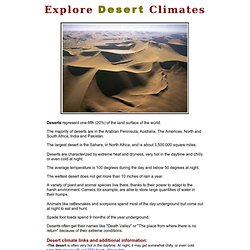
The majority of deserts are in the Arabian Peninsula, Australia, The Americas, North and South Africa, India and Pakistan. The largest desert is the Sahara, in North Africa, and is about 3,500,000 square miles. Deserts are characterized by extreme heat and dryness, very hot in the daytime and chilly or even cold at night. The average temperature is 100 degrees during the day and below 50 degrees at night. The wettest desert does not get more than 10 inches of rain a year. A variety of plant and animal species live there, thanks to their power to adapt to the harsh environment. Animals like rattlesnakes and scorpions spend most of the day underground but come out at night to eat and hunt.
Spade foot toads spend 9 months of the year underground. Deserts often get their names like "Death Valley" or "The place from where there is no return" because of their extreme conditions. Webpage. A desert is a barren area of land where little precipitation occurs and consequently living conditions are hostile for plant and animal life.
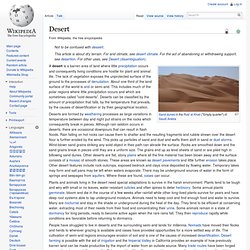
The lack of vegetation exposes the unprotected surface of the ground to the processes of denudation. About one third of the land surface of the world is arid or semi-arid. This includes much of the polar regions where little precipitation occurs and which are sometimes called "cold deserts". Deserts can be classified by the amount of precipitation that falls, by the temperature that prevails, by the causes of desertification or by their geographical location. Deserts are formed by weathering processes as large variations in temperature between day and night put strains on the rocks which consequently break in pieces.
Improving Tourism's Contribution Towards Rhino Conservation. 1.
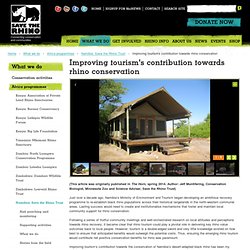
Desert Rhino Camp Credit: SRI (This article was originally published in The Horn, spring 2014. Author: Jeff Muntifering, Conservation Biologist, Minnesota Zoo and Science Adviser, Save the Rhino Trust) Just over a decade ago, Namibia’s Ministry of Environment and Tourism began developing an ambitious recovery programme to re-establish black rhino populations across their historical rangelands in the north-western communal areas. Following a series of fruitful community meetings and well-orchestrated research on local attitudes and perceptions towards rhino recovery, it became clear that rhino tourism could play a pivotal role in delivering key rhino value outcomes back to local people. Improving tourism’s contribution towards the conservation of Namibia’s desert-adapted black rhino has been my primary focus in my role as Science Adviser to Save the Rhino Trust (SRT), a small yet successful rhino conservation NGO based in north-western Namibia. Interesting Facts. African Landforms – Landforms in Africa, Rivers of Africa, Mountain Ranges in Africa.
Print this map Atlas Mountains: This mountain system runs from southwestern Morocco along the Mediterranean coastline to the eastern edge of Tunisia.
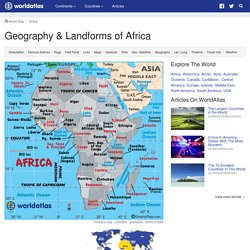
Several smaller ranges are included, namely the High Atlas, Middle Atlas and Maritime Atlas. The highest peak is Mt. Toubkal in western Morocco at 13,671 ft. (4,167 m). See A Life-size Blue Whale! - WDC - Kidzone. Leeson House. Paleoexhibit.
Où voir des dinosaures en France ? 2013%20State%20of%20the%20Birds_low-res. Planet Dinosaur. MAMMALS OF THE WORLD; ALL MAMMALIAN SPECIES. Evolutionary Relationships of Archosaurs. New Jersey 'dinosaur graveyard' may date back to the time of mass extinction. Did Dinosaurs Have Lips? Paleoartist Puts a Face on Ancient Bones. CHICAGO—After careful consideration, Tyler Keillor made a decision: T. rex had lips.
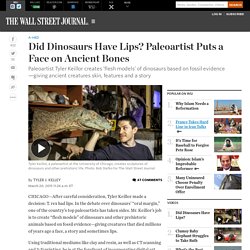
In the debate over dinosaurs’ “oral margin,” one of the country’s top paleoartists has taken sides. Mr. Keillor’s job is to create “flesh models” of dinosaurs and other prehistoric animals based on fossil evidence—giving creatures that died millions of years ago a face, a story and sometimes lips. Using traditional mediums like clay and resin, as well as CT scanning and 3-D printing, he is at the forefront of incorporating digital art and technology into paleontology. Mr. Instead of studying science, he cut his teeth working in a dental laboratory, doing special-effects makeup and studying wig making at Chicago’s Lyric Opera. His skill set was well-suited to Dr. On a recent Thursday, the soft-spoken Mr. The Sereno team’s work on Spinosaurus, a carnivorous, semiaquatic theropod, was detailed in the recent Nova film “Bigger Than T. rex.”
Mostly, however, Mr. “Usually, I give my dinosaurs lips,” Mr. Cheetahs Running in Slow Motion. Aboriginal Afghan Hound.